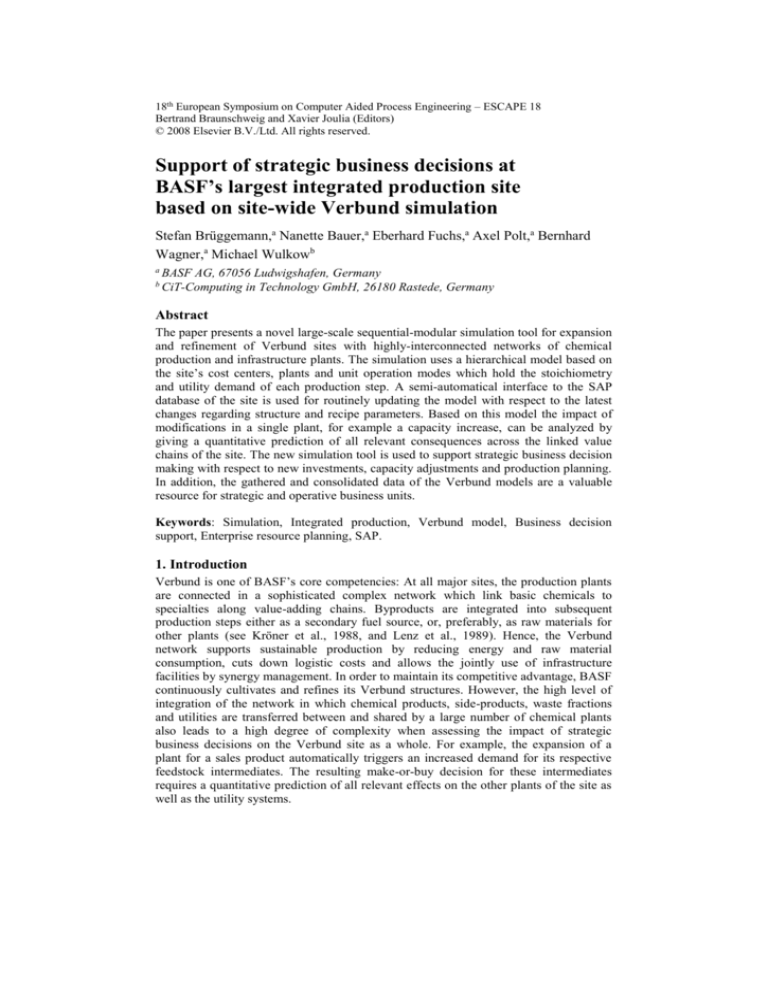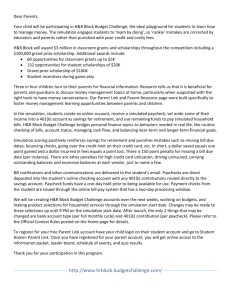
18th European Symposium on Computer Aided Process Engineering – ESCAPE 18
Bertrand Braunschweig and Xavier Joulia (Editors)
© 2008 Elsevier B.V./Ltd. All rights reserved.
Support of strategic business decisions at
BASF’s largest integrated production site
based on site-wide Verbund simulation
Stefan Brüggemann,a Nanette Bauer,a Eberhard Fuchs,a Axel Polt,a Bernhard
Wagner,a Michael Wulkowb
a
b
BASF AG, 67056 Ludwigshafen, Germany
CiT-Computing in Technology GmbH, 26180 Rastede, Germany
Abstract
The paper presents a novel large-scale sequential-modular simulation tool for expansion
and refinement of Verbund sites with highly-interconnected networks of chemical
production and infrastructure plants. The simulation uses a hierarchical model based on
the site’s cost centers, plants and unit operation modes which hold the stoichiometry
and utility demand of each production step. A semi-automatical interface to the SAP
database of the site is used for routinely updating the model with respect to the latest
changes regarding structure and recipe parameters. Based on this model the impact of
modifications in a single plant, for example a capacity increase, can be analyzed by
giving a quantitative prediction of all relevant consequences across the linked value
chains of the site. The new simulation tool is used to support strategic business decision
making with respect to new investments, capacity adjustments and production planning.
In addition, the gathered and consolidated data of the Verbund models are a valuable
resource for strategic and operative business units.
Keywords: Simulation, Integrated production, Verbund model, Business decision
support, Enterprise resource planning, SAP.
1. Introduction
Verbund is one of BASF’s core competencies: At all major sites, the production plants
are connected in a sophisticated complex network which link basic chemicals to
specialties along value-adding chains. Byproducts are integrated into subsequent
production steps either as a secondary fuel source, or, preferably, as raw materials for
other plants (see Kröner et al., 1988, and Lenz et al., 1989). Hence, the Verbund
network supports sustainable production by reducing energy and raw material
consumption, cuts down logistic costs and allows the jointly use of infrastructure
facilities by synergy management. In order to maintain its competitive advantage, BASF
continuously cultivates and refines its Verbund structures. However, the high level of
integration of the network in which chemical products, side-products, waste fractions
and utilities are transferred between and shared by a large number of chemical plants
also leads to a high degree of complexity when assessing the impact of strategic
business decisions on the Verbund site as a whole. For example, the expansion of a
plant for a sales product automatically triggers an increased demand for its respective
feedstock intermediates. The resulting make-or-buy decision for these intermediates
requires a quantitative prediction of all relevant effects on the other plants of the site as
well as the utility systems.
2
S. Brüggemann et al.
In this contribution, we present some experiences on successfully modeling and
simulating BASF’s largest Verbund site worldwide, Ludwigshafen, consisting of more
than 200 plants and 8,000 sales products, each processed from several intermediates or
raw materials. One of the key challenges is the enormous amount of data which is
required to reproduce the network of chemicals, utilities and plants. A new tailor-made
simulation software has been developed which provides interfaces to the databases of
the site’s procurement and resource planning systems (SAP).
2. Structure and characteristics of the Verbund model
Modern modeling and simulation programs have become indispensable tools for the
design and rating of chemical processes. The vast array of different tools can be
categorized by the level of detail of the respective models. Figure 1 illustrates this
categorization and names some industrially important tools. Plant information systems
collect historical measurement data from existing plants. Trend detection and
reconciliation features allow a data-driven assessment and rating of single pieces of
equipment and the performance of the production process as a whole. Equipment design
software targets the sizing and rating of key equipment such as distillation columns or
heat exchangers based on thermodynamics, physical property packages and high-detail
models for heat and mass transfer as well as fluid dynamics. The use of process
simulators such as Aspen Plus has long become state-of-the-art for the design of
complete process flowsheets. They allow capturing the interdependence between major
pieces of equipment and the influence of recycles. Integrated optimization packages and
sizing model libraries assist the identification of cost-optimized operating points
(Wiesel et al., 2006).
In principle, the simulation of a complete Verbund site can be regarded as a flowsheet
simulation which operates on a very large-scale model encompassing all chemical
components, utilities and plants on the site. Regarding the sheer number of components
on a single site, which can easily reach several hundred to thousands, it is, however,
easy to imagine that standard process simulation tools are not well suited for this task.
Instead, BASF decided to create the new custom-made simulation tool SiteMod for sitewide simulation with a highly aggregated model which has been implemented and
jointly developed by CiT.
A Verbund model is built up based on a three-level hierarchy which is closely related to
the structure of the SAP database of the site. Figure 2 illustrates the structure of the
Verbund model with an example. The first level comprises of the plants
Figure 1: Levels of detail in modeling chemical processes
Support of strategic business decisions based on site-wide Verbund simulation
Figure 2: Hierarchical structure of the Verbund model
or, respectively, cost centers on the site. Each plant is subdivided into several
production units (cost subcenters) which define an independent chemical production
facility, e.g. a single production line of a polymer plant.
The description of the chemical process itself is stored in unit operation modes attached
to the production units. The chemistry is given in form of a recipe which balances the
input and output streams of the production unit with respect to chemicals and utilities.
The example shown in Figure 2 describes the recipe for the production of a liquid
intermediate product in the polyamide value chain. Extractsolution 75% is the main raw
material. A small quantity of an alkaline side product is formed in addition to the target
component. The process requires steam at two pressure levels and a small amount of
electricity. Large-scale single-purpose lines, like the one shown here, only have one
single operation mode. On the other hand, multi-purpose units can own several
competing unit modes. Depending on the type of plant the amount of different unit
modes in one unit can grow quite large, e.g. several hundred for compounding and
confectioning lines. In addition to the recipe each unit operation mode has a so-called
alternative capacity which denotes the maximum yearly production if the production
unit is operated with this unit operation mode exclusively.
The amount to which the main product of the unit operation mode is produced is stored
in the portfolio of the unit. Using the concept of the alternative capacities the amount of
produced material per operation mode can be converted to an operating time.
Comparison of the sum of these partial operating times with the total yearly operating
time of the unit then yields the level of capacity utilization. In addition, the overall
material and energy balances of units and plants can directly be deduced from the
portfolios.
3. Integration with the electronic procurement database of the site
The development of Verbund models for site scenarios started in 2002 with the
engineering of BASF’s most recent Verbund site in Nanjing. The availability of a tool
for site-wide balancing offered a significant contribution to the successful conceptual
planning and startup of this new site where the integration of the new plants into several
value chains and utility networks was basically derived from the drawing board. In the
following years, the concept of Verbund simulation was expanded to the sites in
Geismar, Freeport and Antwerp. Up to this point, the models were mainly constructed
3
4
S. Brüggemann et al.
and maintained by hand. When work started on a Verbund model for BASF’s largest
and most diversified site Ludwigshafen in 2004, it soon became apparent that this
approach is not suitable anymore. More than 200 plants with over 900 production units,
approximately 5,800 main products and a total of around 18,000 different chemical and
utility components correspond to an increase of complexity of at least one degree of
magnitude in comparison to any of the other sites. In addition to the monstrous task of
collecting all relevant information at one point in time, the high rate of modifications
with respect to plants, recipes and new products, especially in the specialties and
customized polymers sectors, makes it nearly impossible to keep the model up-to-date
manually. This claim is probably best illustrated by the fact that in 2007 alone more
than 800 new components have been introduced on site.
In order to keep up with the sheer mass of information required for an adequately
concise representation of the Ludwigshafen Verbund, SiteMod has been equipped with
an interface for data import. The enterprise resource planning database (SAP) of the site
is used for the compilation of the raw data. This approach is similar to modern logistics
optimization (see Stadtler et al., 2007). Figure 3 shows the software architecture and
respective interfaces. As part of its administration and accounting modules, the SAP
database contains the current cost center structure and most of the main parameters such
as the alternative capacities as well as planned and historical recipes. These parameters
are collected in a business warehouse (BW) and extracted to an XML-file which is then
imported into a given SiteMod model. A fine-granular parameter blocking mechanism
allows to selectively spare certain parameters from being overwritten by the extracted
input file.
Currently, a present-state site model is generated and updated on a monthly basis. After
importing, the model undergoes a data verification process. The model information is
aggregated into cost center reports which are published in a restricted-access intranet
database. This database is routinely scanned by a data validation team. In case of doubt
this team discusses the respective data with plant management and controlling, whereby
inconsistent SAP information is corrected. As a beneficial side effect of the data
verification process, plant management and controlling are provided with a web access
to a very compact overview of the plants.
Figure 3: Software architecture and integration with the SAP database
Support of strategic business decisions based on site-wide Verbund simulation
SiteMod also provides additional interfaces for the import of parameter tables, e.g. sales
plans for selected components, and the generation of tabular and graphical output for the
documentation of different case studies.
4. Calculation and analysis of site scenarios
In principle, Verbund simulation can be used to target either strategic site development
scenarios or operative optimization. Historically, the main application is the assessment
of the Verbund aspects of investment projects, e.g. new plants or capacity increases in
existing plants. This is done in the form of case studies called site scenarios. These case
studies target questions such as how the degree of utilization of all upstream plants is
affected, if the market prognoses for the related sales products support the planned
capacity of an intermediate, or whether there is additional demand for investment in
order to supply the required raw materials or utilities. Hence, the scenarios provide
important input for the support of strategic business decision making with respect to the
investment.
Figure 4 illustrates the application of Verbund simulation for the benchmarking of an
investment project. A new site scenario usually starts from a collection of historical
information stored in the reference model of the site. This model basically describes the
balances of the plants according to the sales and production data of the previous
financial year. However, the balances are revised in order to remove effects from
singular events such as shortfall of production due to unplanned shutdown, technical
problems or raw material shortage. In essence the model, therefore, describes a perfectly
operated site. The reference model also contains a set of manually edited parameters and
rules which describe constraints on the balances of special components. For example,
the demand of some concentrated acid is first covered by re-concentrating available
amounts of spent diluted acid before it is synthesized from fresh raw material. Another
example is the preferred allocation of production to the most cost-effective of multiple
production lines.
In order to create a new scenario the model is augmented with project-specific
information, such as new plants and new components with their respective market
prognosis. Finally, the model is recalculated by iteratively setting the amounts of
production of all unit operation modes in the portfolio of each production unit to a
desired target. This target is determined according to the desired sales and the internal
demand for the specific component. Rule parameters partition the production in case
Historical
Historical
information
information
Project-specific
Project-specific
information
information
• Reference model
• Previous sales and
production data
• Market prognosis
• New or changed plants,
capacities and recipes
Verbund
Verbund simulator
simulator
Optimization of
capacity utilization
Scenarios
-- assessment
assessment
Profitability
Profitability €€
benchmarking
benchmarking
Investment
approval
Figure 4: Application of Verbund simulation for benchmarking of investment projects
5
6
S. Brüggemann et al.
multiple unit operation modes exist for the production of the same component.
A sequential-modular approach has proven to be most suitable for converging the
overall site balance out of two reasons. First, it readily supports a step-by-step analysis
of the balance changes and, if necessary, adjustment of the rule parameters. Secondly, it
allows isolation of singularities and other numerically unwanted effects in the model.
For example, singularities frequently arise when component A is not only produced
from component B in one unit operation mode but also reprocessed to B in another one.
Whereas this situation is perfectly valid for accounting in SAP, it can, depending on the
rule parameters, be a major hassle for the simulation.
The resulting balances of the scenario can readily be compared to the reference model
or, respectively, to alternate scenarios in form of a -assessment. This assessment
shows the changes of the site balance with respect to the overall component balance and
the utilization of the plants. Successive scenario calculations can then be used to refine
and optimize the integration of productions within the Verbund.
5. Use of Verbund simulation as an operative site information tool
In addition to the economic assessment of investment projects the data in the Verbund
model can also be used as a site information tool for midterm operative planning. Based
on a five-year sales forecast the corresponding plant portfolios are calculated using the
reference model. Where applicable, scheduled capacity increases resulting from
debottlenecking and, vice versa, capacity decreases, e.g. from planned turnarounds, are
considered. The resulting production plan is published in a SAP BW/Intranet database
and provides the plant managers with information on the expected utilization of their
plant and, in case of multi-product plants, on the distribution of the product portfolio
(cf. Figure 3). Recently, this planning module has been expanded to additionally
propose a site-wide forecast of energy and utility consumption.
6. Conclusions and future work
A novel software tool for site-wide balancing of chemicals and utilities has been
introduced. The tool enables visualization and refinement of integrated production at a
Verbund site based on data from an enterprise resource planning database (SAP). It is
used for the economic benchmarking of the site aspects of investment projects. In
addition, it is the basis for setting up the midterm operative production and utility
forecast of the site. Future work will focus on exploiting the data contained in the
Verbund model for additional operative aspects. Ideas range from optimization of
product allocation during periods of raw material shortage to the application for tolling
purposes. On a long-term scale the extension to multi-site Verbund simulation is
targeted.
References
H. Körner, 1988, Optimaler Energieeinsatz in der chemischen Industrie, Chemie Ingenieur
Technik, 60, 7, 511-518.
H. Lenz, M. Molzahn and D. W. Schmitt, 1989, Produktionsintegrierter Umweltschutz –
Verwertung von Reststoffen, Chemie Ingenieur Technik, 61, 11, 860-866.
H. Stadtler and C. Kilger, 2007, Supply Chain Management and Advanced Planning: Concepts,
Models, Software and Case Studies, Springer Verlag, Berlin.
A. Wiesel and A. Polt, 2006, Conceptual steady state process design in times of value based
management, Proc. ESCAPE 16, Elsevier, 799-804.






